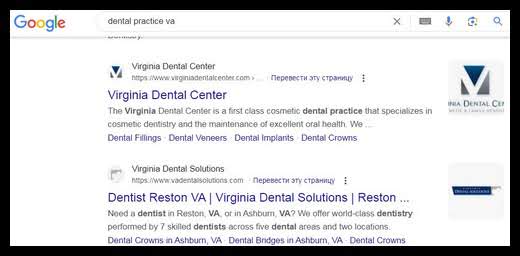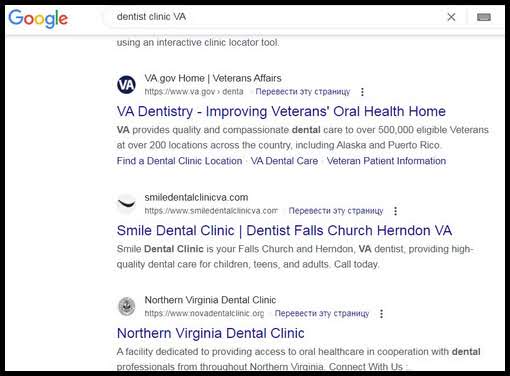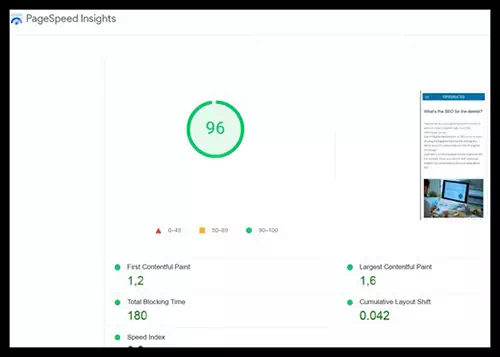What’s the SEO for the dentist?
The internet is a vast digital realm with millions of websites. Search engines help users find information quickly.
Search Engine Optimization, or SEO, is the practice of using strategies to improve the ranking of a dental practice’s online assets on search engines like Google.
Local SEO is a more targeted subset of general SEO. For example, if you are a dentist with a physical location, you would want to focus on local dental SEO.

Benefits of Local SEO For Dentists?
For a dental practice, there are many benefits to be gained from search engine optimization including:
Enhanced Local Awareness

When your dental practice appears higher in search results, more people in your community will discover your practice, which can lead to an increase in new patient inquiries.
Enhanced website traffic
Implementing dental SEO tactics will boost your online presence, resulting in increased traffic to your website, social media pages, and Google business profile.
With more traffic, you can increase the chance of converting visitors into scheduled patients and receiving more phone calls.
Connect With Patients Early

SEO is an effective strategy to attract potential patients who are looking for a new dentist.
By offering valuable information and resources that cater to their needs and concerns, you can establish a connection and gain their trust in your dental practice.
This can greatly enhance your online visibility and help you grow your patient base.
Improving Competitive Advantage
Improving your online rankings and increasing online traffic can help you generate more leads, which in turn can give you an edge over your competition.
This is particularly important when competing with other dentists in your area as well as larger dental organizations with bigger marketing budgets.
By investing in local dental SEO, you can establish a strong presence in your community, making it difficult for competitors to challenge your position.
SEO is Free
Dental SEO is a cost-effective alternative to traditional marketing methods like paid advertising.
Although it requires time and effort, it doesn’t involve paying for patient leads. With a willingness to commit to the work, SEO can become one of the most effective ways to market your dental practice.
In the long run, the benefits of SEO for dentists will surpass those of other marketing initiatives.
How SERP’s Work
SERP is an acronym for Search Engine Results Page. It’s the page of results that appears after an online search.
There’s a lot of search engines, but Google is the biggest one.
Top Search Engines
Search Engine Optimization for dentists begins with crawling and indexing

When you search for something on Google, you are not browsing the entire internet directly. Instead, you are performing a search on Google’s web version. The internet is a chaotic place where websites are scattered without any order. Search engines like Google bring order to this chaos by finding web pages through links and then indexing them. Indexing involves analyzing the content of the page and storing the data for future search convenience. Search robots are digital agents created by search engines to study the internet and document their findings, which allows them to index them efficiently for users. These agents index billions of pages daily and browse millions of new ones by following links to content. Such links serve as guides for search robots to discover new information. This process of link creation is crucial for dental SEO optimization, highlighting the power and importance of proper interlinking. Crawlers ensuring that you can effortlessly find what you’re looking for when you use search engines. Their meticulous work of identifying, copying, and indexing content allows platforms like Google, Yahoo, and Bing to deliver the results we’ve come to rely on.
So when someone in digital marketing or a web developer mentions that your website isn’t indexed, it means that the search engines can’t find it.
How do dental websites rank in search engines?

The primary objective of a search engine is to display a relevant set of search results as quickly as possible. If a search engine can provide consumers with what they need, they are more likely to use it again. As a dental practice, you can appear at the top of the page in Local Service or Google ads, in the local map results, or in the organic results below the Google map. By implementing dental SEO strategies, you can improve your rankings on the Google map and organic results.
12 SEO Strategies for Dentists to improve their online presence
1#. Check For Errors in Technical SEO
Search engines such as Google aim to provide users with the most relevant and useful search results. However, if your website takes a long time to load and visitors leave soon after arriving (bounce), it is unlikely to be considered a top search result.
To ensure that your website is technically optimized and meets the requirements of search engines, it should:
- Load quickly
- Be easily accessible to search engines
- Include a robots.txt file
- Be free of dead links
- Avoid duplicate content
- Be SSL/HTTPS secure
- Incorporate structured data
- Feature a site map
By following these guidelines, you can greatly improve the chances of your website being ranked highly in search engine results pages (SERPs).
2#. Improve Page Speed Load Times

It’s important to note that if a website takes more than 3 seconds to load, 40% of the visitors will leave the site. This can negatively impact your website’s ranking on Google search results, as it indicates poor user experience. To check your website’s load speed, you can use Google’s Page Speed Insight or other tools available online. It’s crucial to keep your website up to date, and one of the recent requests from Google is to convert all images to the WebP format. This format allows higher-quality images to be displayed with smaller file sizes, making it a better option than PNG or JPEG files.
3#. Claim Your Google Business Profile
Your dental practice can have a Google Business Profile (GBP) for free. This allows you to manage how your practice information appears across Google products, such as Google Maps and Search. It is the first step in optimizing and ranking higher on the Google map. When potential patients search for a dentist near them, they often look at the Google map. Your Google Business Profile will showcase crucial details like your location, operating hours, contact details, reviews, and practice photos.
Why Is This Critical for Ranking Success?
- Firstly, a well-optimized GBP ensures that your dental practice appears in local search results, as many patients use Google Maps to find nearby dental offices.
- Secondly, positive reviews, ratings, and accurate information on your GBP build trust with potential patients.
- Thirdly, GBP enables you to post updates, photos, products, offers, or events, which helps in engaging with potential and existing patients effectively.
- Finally, GBP’s built-in analytics provide insights into how patients find your practice and where they come from.
How To Claim Your Google Business Profile
To find your business listing on Google, simply search for the name of your practice. If you are logged into a Google account that owns or manages the listing, you will see editing capabilities at the top of the search results.
To ensure that you can edit your business listing, you need to verify if it has been claimed. If you cannot see the editing panel in search, it is possible that your listing has not been claimed yet. To verify if your listing has been claimed, check for a “Claim This Business” link on the right-hand side of the search results in the knowledge panel. Click on the link, and you will be prompted to claim the listing. Alternatively, you may see a partial email of the Google account that owns the listing.
4#. Update Your Google Business Profile
After claiming your profile, you can improve your listing by adding more useful information that can improve its ranking. The initial step is to ensure that your NAP (Name, Address, and Phone) details are accurate. It’s recommended to use the USPS address for GBP listings.
5#. Optimize Your Google Business Profile
Once you have claimed and verified your NAP (Name, Address, Phone) information, it’s time to optimize your Google Business Profile. Here are some steps to follow:
1. Primary Category: If you are a dentist, use “Dentist” instead of “Dental Clinic”.
2. Secondary Category: Choose 2-3 secondary categories if you offer multiple services.
3. Services: Add all the services you offer in the services section.
4. Location: Use all twenty location slots.
5. Posts: Start posting at least twice a month and link to your website.
6. Scheduling Link: Add a scheduling link, if you have one.
7. Insurances: Update accepted insurances.
8. Products: Add products if you offer them.
9. Photos: Add at least 50 images and continue to add images much like you would to your social media accounts.
6#. Select the Correct Keywords for SEO
One of the first steps in SEO for dentists is to identify the services you want to optimize for. Optimizing for major keywords is one strategy. The top 5 keywords for dentists are:
- Dentist in [your area]
- [Your area] dentists
- Best dentists in [your area]
- Dentists near [your area]
- Emergency dentist [your area]
Another strategy is optimizing for long-tail keywords, which are more specific and usually longer than commonly searched words. Long tail keywords get less traffic, but they are generally easier to optimize for.
An example of long-tail keywords would be:
- dentist that accepts medical insurance
- dental implants for seniors
- best teeth whitening products dentist approved
- all on four dental implants near me
- family dental office near me
7#. Blog for SEO Benefit

Blogs have become more critical than ever as an SEO for dentists’ strategy.
When the blog content on your site is valuable and engaging, your potential patients view your practice as a trusted source.
Google recognizes this, and it’s an indication that you’re creating useful content. Your blog posts will improve in the search engine results pages.
The best dental SEO services always leverage blog posts.
8#. Never use Anything but Original Copywriting
If you want to keep your website unique and engaging, it is suggested that you develop your website on a user-friendly platform like WordPress, and incorporate either the Yoast or Rank Math plugins. These plugins inspect each page on your website and provide you with guidance on how to enhance the page for a particular keyword. This will help you to optimize your content and improve your website’s search engine ranking.
9#. Create Local Inbound Links
Inbound links, also known as external links, refer to links on other websites that direct to your website. For instance, a link from a local business directory or an article about oral health in an online magazine that links to your website. Dental SEO experts consider inbound links as the most powerful source of ranking power for your dental SEO marketing.
Google uses inbound links to gauge the quality and relevance of your dental practice. It is an easy way for Google to determine why your dental practice is better than others. Google does not have someone on the ground in your community evaluating dental practices. The more people talk and link to a dental practice, the more Google sees it as reputable.
The quality of the website linking to you determines the value of the inbound link. If the website is reputable, established, has a lot of traffic, and many other links, Google will perceive it as a reputable link. Inbound links are similar to votes of confidence. Google evaluates the trustworthiness of your website based on the types of inbound links you have.
However, if the website linking to you has only been online for a few days, has no traffic or links, it is a weak link. Weak links can be spam and can harm your rankings. Therefore, you need to be careful about the links you acquire.
Building Inbound Links With Citations
Have you been approached by a dental marketing organization or your dental SEO company with the suggestion that you need to create more dental citations? If you’re not sure what a dental citation is, don’t worry, you’re not alone.
Citation creation and clean-up, also known as directory creation and clean-up, is an essential part of any effective search engine optimization (SEO) strategy. Citations are essentially inbound links to your dental website that help establish it as a reliable source.
It’s important to note that not all citations are directory and local listings, although all directory and local listings are citations. So, if you’re looking to increase your citation count, submitting your practice information to directories is one way to accomplish this.
10#. Have a Strong Internal Linking Strategy

Internal links refer to links from one page of your website to another. For instance, you may have a blog post that discusses dental implants and provides a link to your dental implant service page. These links are crucial because search engine spiders rely on a crawlable link structure to navigate a website’s architecture. When a new page is discovered via a link, it can be indexed and made available to users. Therefore, internal links help ensure that all pages on your website are discovered and indexed by search engines.
11#. Update to Mobile Optimized Website
Mobile optimization is crucial for websites as it’s built with a mobile-first approach. This approach allows websites to adjust their format according to the mobile screen size, making it easier for mobile users to navigate through the site. A mobile-optimized website ensures a seamless user experience, thereby becoming an effective SEO strategy.
12#. Post Consistently to Social Media

Are you aware that your dental practice’s social media activity is considered in the ranking algorithm? This means that dental practice SEO and social media marketing go hand in hand. By staying active on your social media accounts, you can boost your Google rankings and enhance your online presence.
Frequently Asked Questions

If a dentist wants to attract new patients, they should consider implementing dental SEO strategies as part of their marketing efforts.
As a dentist or dental practice manager, it is important to keep track of various indicators and metrics related to dental SEO performance. Some of these metrics include website and social media impressions, organic rankings, local SEO rankings, backlinks, service pages and blog articles ranking, domain and dental page authority, clicks, conversions, and new patient phone calls. Keeping an eye on these metrics can help you optimize your dental SEO strategy and improve your practice's online visibility.
If a dentist wants to attract specific patients, their SEO campaign can be tailored to focus on those patients. For instance, if they want to attract patients who need dental implants, the campaign can be designed to rank the practice as high as possible for dental implant-related keywords. Similarly, if the practice aims to attract patients from a specific geographical area, the SEO campaign can be optimized for that area.
If you integrate a dental SEO strategy into your marketing campaign, you can expect to experience several benefits. Firstly, your practice will become more visible online, which will increase your website visitors. Secondly, your website visitors will have a better experience with your brand. Thirdly, your practice will gain higher credibility and trustworthiness through significant social proof. Fourthly, you will experience higher conversion rates of website visitors to scheduled appointments. Fifthly, you'll be able to attract the right kinds of patients. Finally, you'll see an improvement in all your online marketing initiatives through transference.
The success of your website is dependent on both the technical aspects and user experience rather than just the aesthetics. Search engines like Google, Yahoo, and Bing do not prioritize the appearance of your website. However, for dental practices, aesthetics are crucial because of a concept known as transference. This means that people tend to associate the emotions they feel for one thing with another unrelated thing.
Lean on us in the training of dental SEO
If you are looking to attract new dental patients but don’t know where to begin or simply don’t have the time to start, we can assist you. Fill out a form to receive a personalized, no-obligation dental SEO summary and quote.








